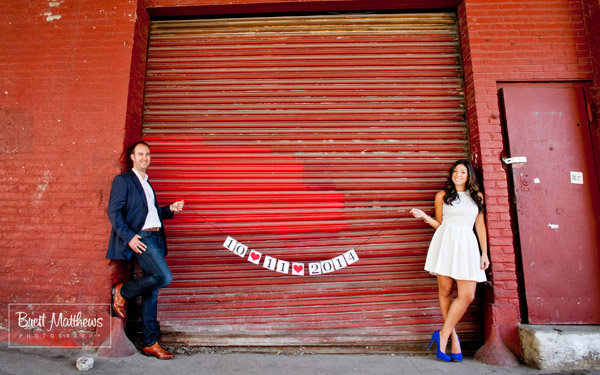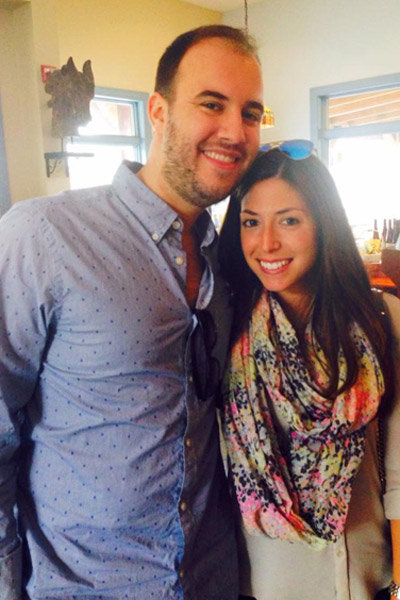Thinking about straightening out your pearly whites? Learn how much Invisalign costs, when to do it, what to expect and more.
By: Rachel DichterMy quest for the perfect smile began after I got my engagement photos back from my fabulous photographer, Brett Matthews. I absolutely loved them! However, I couldn't help but obsess over how my teeth looked in close-ups.
No stranger to cosmetic dentistry, I had metal braces from the ages of 12 to 15, and when I had them taken off, my teeth were perfect. However, I stopped wearing my nighttime retainer long ago, and over the years, they gradually shifted. (The fact that I didn't remove my crowded wisdom teeth until I was an adult certainly didn't help!)

As the Fashion Advertising Manager at Bridal Guide, I knew how important wedding photos are and I decided that I didn't want to look back at my album and be disappointed with the way I looked. At that point, I had one year left to go until my October 2014 wedding and I hoped that it would be enough time to improve my smile. I personally couldn't bear the thought of wearing traditional metal braces again at the age of 25, so I decided to explore Invisalign, an orthodontic treatment that uses a series of clear, removable trays to align the teeth.
I scheduled a consultation with Dr. Jacquie Fulop-Goodling, an orthodontist who specializes in this procedure, and we hit it off right away! Here's what I learned throughout my journey:
1. Invisalign can improve your dental health.
Although many patients turn to Invisalign for cosmetic reasons (including myself), there are also health benefits to fixing malocclusions or "bad bites." Crowded teeth accumulate more bacteria, which can cause gum problems, linking it to heart disease, diabetes and low birth weight babies. As long as you have no cavities or gum disease, there isn’t any medical reason not to choose Invisalign.
2. Start your treatment at least one year prior to the big day.
The average adult orthodontic treatment takes about 11 to 12 months to complete. If it's less than one year before the wedding, you may still experience a noticeable difference in your photos even if you have to continue your visits after returning from your honeymoon. (When patients start to see results is subjective — some see improvement as early as one-third of the way through treatment while others don't experience that "wow!" moment until the very end.)
Many Invisalign patients also opt to have their teeth professionally whitened so if that's the case, you'll want to allocate some additional time. I will be whitening my teeth with the Zoom laser a few weeks before my wedding. Fun fact: You can only eat white or clear foods (think soup broth or bread) for two days following the procedure. That way, your teeth don't stain!
3. Choose an orthodontist in a convenient location.
Dr. Jacquie has eight different locations spread throughout Long Island, New Jersey and Manhattan, one of which is just a few blocks away from Bridal Guide's New York City office. Since I had to go back to the doctor every few weeks or so to adjust my treatment, I was able to fit appointments in during my lunch break. Choosing an office that is close to your home or place of business becomes especially important during the later months of wedding planning, when your schedule gets even more hectic.
4. Each orthodontist has their own signature smile aesthetic.
Before undergoing Invisalign, I looked through Dr. Jacquie's "Smile Look Book," which featured tons of brides and grooms with picture-perfect smiles. I was sold: I couldn't help picturing my own wedding photos and imagining how much happier I would feel if I had straight teeth like theirs.
Dr. Jacquie taught me that no two Invisalign patients' smiles will look exactly the same. The process is akin to choosing a plastic surgeon; if you went to five different surgeons for a rhinoplasty, you would have five different-looking noses. Therefore, it's important to see examples of an orthodontist's work so you can determine what the end result will potentially look like.
5. There are key differences between Invisalign and regular braces.
Invisalign trays are less noticeable and more aesthetic than traditional braces. Another bonus is that there aren't any food restrictions since you take them out when you eat. The cost is about the same as clear ceramic braces and some dental insurance plans will even cover part of it.
You will feel some pressure the first day or so after you switch to the next tray, but overall, I found them to be more comfortable than metal braces because there are no wires poking out. It takes about a week to get adjusted to speaking with them, removing them to eat and cleaning them. I try to wear my Invisalign as often as possible (it is recommended to wear the trays 22 hours per day). For those of you who are wondering, yes you'll have to sleep with them in every night (no exceptions!).
6. Maintain a healthy and radiant smile on the big day.
Avoid red wine at all costs the week leading up to your wedding. On the morning of the big day, wet your toothbrush with a capful of hydrogen peroxide (yes, the kind that comes in the ugly brown bottle), dip it into a box of baking soda and apply the mixture to your teeth. According to Dr. Jacquie, this will neutralize your breath and help to brighten your smile.
Also, after applying your lipstick, use a chapstick with a fresh minty scent on the inside of your lips. As the bride, you will be the center of attention and everyone will want to get up close and personal with you. The groom and your guests will thank you later!

The final verdict:
I'm almost done with my Invisalign treatment and I’m extremely happy with the results. It fixed my overbite, broadened my smile and straightened my teeth perfectly. I would highly recommend it to any bride who isn’t in love with her smile!


